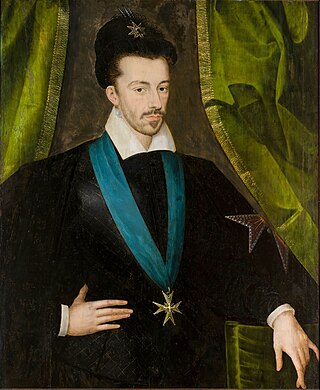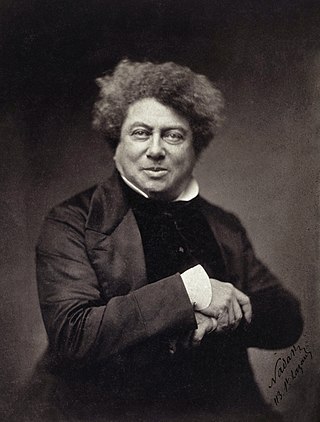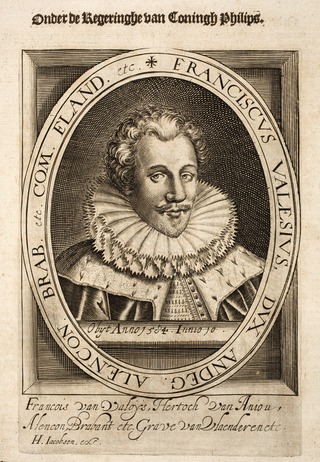
Henry III was King of France from 1574 until his assassination in 1589, as well as King of Poland and Grand Duke of Lithuania from 1573 to 1575.

The Château de Montsoreau is a Flamboyant Gothic castle in the Loire Valley, directly built in the Loire riverbed. It is located in the small market town of Montsoreau, in the Maine-et-Loire département of France, close to Saumur, Chinon, Fontevraud-l'Abbaye and Candes-Saint-Martin. The Château de Montsoreau is situated at the confluence of two rivers, the Loire and the Vienne, and the meeting point of three historical regions: Anjou, Poitou, and Touraine. It is the only château of the Loire Valley built directly in the Loire riverbed.

The French Wars of Religion is the term which is used in reference to a period of civil war between French Catholics and Protestants, commonly called Huguenots, which lasted from 1562 to 1598. According to estimates, between two and four million people died from violence, famine or diseases which were directly caused by the conflict; additionally, the conflict severely damaged the power of the French monarchy. The fighting ended in 1598 when Henry of Navarre, who had converted to Catholicism in 1593, was proclaimed Henry IV of France and issued the Edict of Nantes, which granted substantial rights and freedoms to the Huguenots. However, Catholics continued to have a hostile opinion of Protestants in general and of Henry, and his assassination in 1610 triggered a fresh round of Huguenot rebellions in the 1620s.

Alexandre Dumas, also known as Alexandre Dumas père, was a French novelist and playwright. His works have been translated into many languages and he is one of the most widely read French authors. Many of his historical novels of adventure were originally published as serials, including The Count of Monte Cristo, The Three Musketeers, Twenty Years After and The Vicomte of Bragelonne: Ten Years Later. Since the early 20th century, his novels have been adapted into nearly 200 films.
Joseph Boniface de La Môle was a French nobleman. He was the son of Jacques Boniface, seigneur de la Môle et de Colobrières, of Marseille.

Henry I, Prince of Joinville, Duke of Guise, Count of Eu, sometimes called Le Balafré ('Scarface'), was the eldest son of Francis, Duke of Guise, and Anna d'Este. His maternal grandparents were Ercole II d'Este, Duke of Ferrara, and Renée of France. Through his maternal grandfather, he was a descendant of Lucrezia Borgia and Pope Alexander VI.

MonsieurFrancis, Duke of Anjou and Alençon was the youngest son of King Henry II of France and Catherine de' Medici.
The War of the Three Henrys, also known as the Eighth War of Religion, took place during 1585–1589, and was the eighth conflict in the series of civil wars in France known as the French Wars of Religion. It was a three-way war fought between:

La Dame de Monsoreau is a historical novel by Alexandre Dumas, père published in 1846. It owes its name to the counts who owned the famous château de Montsoreau. The novel is concerned with fraternal royal strife at the court of Henri III. Tragically caught between the millstones of history are the gallant Count de Bussy and the woman he adores, la Dame de Monsoreau. Chicot the Jester is a character in the novel, and in some English translations he is the title character.

La Reine Margot is a 1994 historical romantic drama film directed by Patrice Chéreau, from a screenplay he co-wrote with Danièle Thompson, based on the 1845 historical novel of the same name by Alexandre Dumas. The film stars Isabelle Adjani, Daniel Auteuil, Jean-Hugues Anglade, Vincent Perez and Virna Lisi. An abridged version of the film was released as Queen Margot in North America, and in the United Kingdom under its original French title.

Michel de Castelnau, Sieur de la Mauvissière was a French soldier and diplomat, ambassador to Queen Elizabeth. He wrote a memoir covering the period between 1559 and 1570.

Margaret of Valois, popularly known as La Reine Margot, was a French princess of the Valois dynasty who became Queen of Navarre by marriage to Henry III of Navarre and then also Queen of France at her husband's 1589 accession to the latter throne as Henry IV.
The Forty-five guards were recruited by Jean Louis de Nogaret de La Valette, Duke of Épernon to provide Henry III of France with trusted protection in the midst of the War of the Three Henrys.

Auguste Maquet was a French author, best known as the chief collaborator of French novelist Alexandre Dumas, père, co-writing such works as The Count of Monte Cristo and The Three Musketeers.

Catherine of Cleves, Countess of Eu was the wife of Henry I, Duke of Guise and the matriarch of the powerful and influential House of Guise. By marriage, she was Duchess of Guise from 1570 to 1588, and Dowager Duchess of Guise thereafter. She was also Countess of Eu in her own right from 1564.
Chicot, real name Jean-Antoine d'Anglerais, was the jester of King Henry III of France and later Henry IV. He was sharp-tongued and very cunning, and spoke with the king without formalities.

La Reine Margot is a 1954 French-Italian adventure historical drama film directed by Jean Dréville, scripted by Abel Gance from the 1845 novel La Reine Margot by Alexandre Dumas. It stars Jeanne Moreau, Armando Francioli and Françoise Rosay. The film is also known under the alternative title A Woman of Evil.

La Reine Margot is a historical novel written in 1845 by Alexandre Dumas, père. Although it is based on real characters and events, certain aspects of La Reine Margot may be inconsistent with the historical record; historians have attributed that to artistic licence and the fact that Dumas might have been influenced by propaganda against certain historical figures, notably Catherine. Written in French, it was almost immediately translated into English, first anonymously and soon afterward publicly by David Bogue as Marguerite de Valois: An Historical Romance.
Françoise de Maridor was a French courtier, a lady in waiting to Catherine de Medici.













